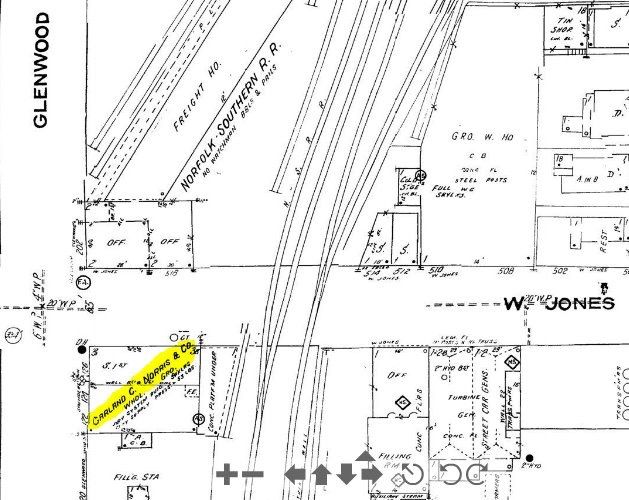A gentle correction:
The Raleigh and Eastern North Carolina Railroad was organized in 1903 and renamed the Raleigh and Pamlico Sound Railroad in 1905. In 1906, it built a line from the end of the N&S at Washington south to Bridgeton, as well as a completely separated line from Raleigh east to Zebulon.
On November 24, 1906, the Norfolk and Southern Railway was formed as a consolidation of the Norfolk and Southern Railroad with the Raleigh and Pamlico Sound Railroad and several other companies. Eventually, the line was continued south of Raleigh, terminating in Charlotte by 1911.
Norfolk and Southern’s Raleigh operations were centered around the still standing (Google Fiber) structure at the corner of Jones Street and Glenwood Ave (then called Saunders Street) with the main office at the time being at Norfolk Terminal Station. Freight tracks and structures extended northward from Jones Street, with the bulk of the switching and turntable activity occurring at Glenwood Yard.
Once complete, passenger operations were two-fold. There was daily service between Raleigh and Norfolk which called at the 1890 Raleigh Union Depot on Dawson Street. And, there was daily service to Varina and Fayetteville which called at Jones Street. The original Norfolk and Southern never ran competing passenger service to Charlotte.
The Richmond & Danville Railroad (later the Southern Railway after 1894) had the operating lease over the North Carolina Rail Road. Passenger operations called at Dawson Street until 1949, moving to their own (now-demolished) depot adjacent to the freight yard operations and turntable located on Cabarrus Street.
The structure at 126 Glenwood was built by the Garland C Norris & Co. as a wholesale grocer. Originally started in Apex, the business moved to Raleigh in 1921 opposite the NS terminal station with a freight siding on the back. They later expanded to Florida to can and distribute citrus products, eventually moving back to Apex. They are still in existence with the third and fourth generation still owning and managing the company.
But, when Garland Norris & Co moved back to Apex, Percy Daniel (‘P. D.’) Snipes set up grocery operations in the same building, giving employees of the railroad signature based accounts. Known affectionately as ‘The Grab.’ Of note, ‘P. D.’ was mayor of Raleigh from 1947-1951.
According to my references at the Norfolk and Southern Historical Society, it had business contracts with the railroad and it’s employees as well as the neighboring business community as well.
(Image from Sanborn, 1950)

